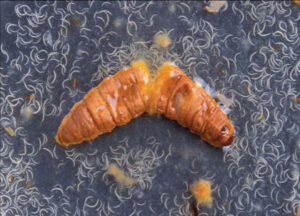Predatory nematodes provide biocontrol option for canola pests
Key result:
Although impact varied among species, predatory nematodes belonging to the Steinernema genus provided significant mortality of diamondback moth, lygus bug, cabbage root maggots and black cutworms.
Project title, principal investigators:
“Biocontrol potential of entomopathogenic nematodes (EPNs) against selected key insect pests of canola in Alberta” Shabeg Briar and Paul Tiege, Olds College
Funding:
Alberta Canola
Crop losses and the economic impact caused by canola insect pests can be substantial. The resistance to chemical control is also a growing problem – as the number of options are shrinking over time. A commercially available biocontrol agent that is largely unexplored in the Canadian Prairies is the use of entomopathogenic nematodes (EPNs). These predatory nematodes are soil-dwelling round worms that specialize in parasitizing insects.
Researchers Paul Tiege and Shabeg Briar produced base line information on the biocontrol potential of four predatory nematode species: Heterorhabditis bacteriophora, Steinernema carpocapsae, S. kraussei and S. feltiae. Four concentrations of nematodes were examined against foliar insect pests (flea beetles, diamondback moth larvae and lygus bugs) using Petri dishes and below ground pests (cabbage root maggots and black cutworms) using sandy soil in plastic cups, in controlled laboratory conditions. Insect mortality was assessed after 72 hours of exposure to the nematodes and observed under the microscope to confirm nematode infection.
In general, mortality rates of most insects increased with increasing nematode concentrations. Specific impacts on different insect pest species are outlined below.
Diamondback moth: Mortality rates for larval diamondback moth ranged from 33-63 per cent at low nematode concentrations and 60-90 per cent at high concentrations. Mortality of diamondback moth pupae was generally lower than larvae, with rates across species ranging from 30-40 per cent at low nematode concentrations to 50-70 per cent at high nematode concentrations.
Lygus bugs: Of the three Steniernema species tested against lygus bug nymphs, S. kraussei generally produced the highest mortality rates, followed by S. carpocapsae and then S. feltiae. Mortality rates for lygus bugs were 39-50 per cent at low nematode concentrations and 62-87 per cent at higher concentrations.
Flea beetles: Unfortunately, very low mortality rates (10 per cent or less) were reported for adult flea beetles, even at the highest concentration of nematodes.

Black cutworm larvae: Mortality rates for black cutworms were 10-80 per cent for low nematode concentrations, 85-100 per cent for high concentrations. H. bacteriophora provided a high average mortality of 95 per cent at the highest concentration, but resulted in much lower mortality rates than the other species at all other concentrations. At the 95 per cent confidence interval, the LC50 value of all Steniernema species were significantly lower than those of H. bacteriophora.
Cabbage root maggots: The H. bacteriophora and S. carpocapsae species resulted in no to low mortality to cabbage root maggot larvae, at any concentrations. The other two species tested (S. feltiae and S. krausse) produced progressively higher mortality rates with increasing nematode concentrations, ranging from 8-17 per cent at low concentrations and up to 83 per cent at high concentrations. Pupal stage of root maggots appeared to be resistant to all EPN species and showed no host penetration of the pupal stage.
Further studies on the exploration of locally adapted strains is already underway in the follow up project funded by RDAR and Alberta Canola.







